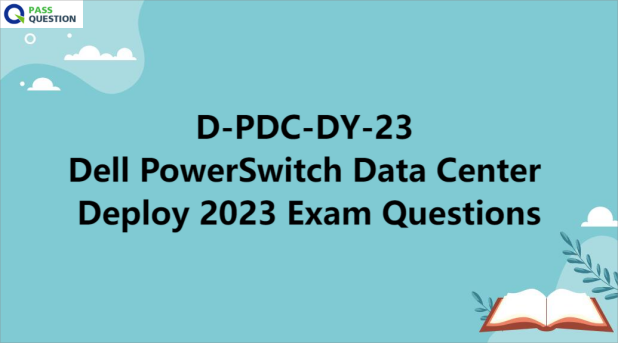
D-PDC-DY-23 Dell PowerSwitch Data Center Deploy 2023 Exam Questions
Are you preparing yourself to take on the Dell EMC D-PDC-DY-23 certification exam in 2024? PassQuestion offers the most up-to-date D-PDC-DY-23 Dell PowerSwitch Data Center Deploy 2023 Exam Questions which cover all the essential topics and concepts that you will be tested on in the certification exam. By utilizing our D-PDC-DY-23 Dell PowerSwitch Data Center Deploy 2023 Exam Questions, you can enhance your exam preparation and significantly increase your likelihood of successfully passing the exam with outstanding results.

Dell PowerSwitch Data Center Deploy 2023
This exam focuses on concepts related to the Data Center environment and Dell Networking's S-Series and Z-Series products. Focus is on Dell Networking SmartFabric OS10-based protocols and features. This certification validates the ability to perform intermediate skill level tasks in installing, configuring, maintaining, and troubleshooting Dell PowerSwitch Data Center Networking products.
Part 1 of the exam has a duration of 90 minutes and consists of approximately 60 questions. In order to pass, a score of at least 63% is required. Part 2 of the exam has a duration of 30 minutes and includes around 6 simulations. To pass this part, a score of at least 66% is needed. Both parts of the exam must be passed in order to achieve certification.
D-PDC-DY-23 Exam Objectives
Network Overview (5%)
● Identify the main components within the Data Center portfolio
● Review common Data Center networking topologies
FHRP (10%)
● Identify VRRP components
● Outline VRRP operation and behavior
● Configure and verify the operation of VRRP in OS10
Link Redundancy (20%)
● Describe the components that makeup a VLT configuration
● Configure and verify the operation of VLT in OS10
● Outline the components of UFD
● Configure and verify the operation of UFD in OS10
IP Routing (20%)
● Describe the components of OSPF
● Review the operation and behavior OSPF
● Configure and verify a single area of OSPF topology
● Outline the main components in BGP
● Configure and verify the operation of BGP
● Describe Policy-Based Routing (PBR) basic operations
● Configure and verify the operation of PBR
Security (10%)
● Configure and verify ACLs in OS10
● Outline the components of AAA security
● Configure and verify the operation of AAA Security in OS10
Data Center Technologies (30%)
● Describe the operation and use case for VRF
● Configure and verify the operation of VRF in OS10
● Outline the basic operation of QoS
● Review traffic identification, marking and prioritization in QoS
● Configure and verify the operation of QoS in OS10
● Outline the basic operation of IP Multicast
● Configure and verify IGMP and PIM protocols
● Configure and verify the operation of Multicast in OS10
● Outline the operation of NTP, PTP, and Synch-E
● Configure and verify the operation of Network timing protocols
Network Automation (5%)
● Describe the rationale for network automation
● Examine the components within Smart Fabric Services and OMNI
● Configure and verify operation of SFS and OMNI
View Online Dell PowerSwitch Data Center Deploy 2023 D-PDC-DY-23 Free Questions
1. Which user role in OS10 has full access to all commands and exclusive access to commands that manipulate the file system?
A. netadmin
B. sysadmin
C. secadmin
D. netoperator
Answer: B
2. A network administrator is troubleshooting a PBR implementation and needs to know how many packets have matched the route-map criteria. How do they view this information in OS10?
A. OS10# show route-map
B. OS10# show interface statistics
C. OS10# show route-maproute-map-statistics
D. OS10# show route-mappbr-statistics
Answer: D
3. What must be done before configuring any routing protocol in a VRF instance?
A. Assign an IP address to at least one of the interfaces assigned to the VRF instance
B. Create a routing group for each VRF instance
C. Assign each VRF instance to a routing group
D. Nothing, VRF routing protocols are assigned automatically
Answer: A
4. What configuration must be common on iBGP neighbors to form an iBGP adjacency?
A. Local preference
B. Router-ID
C. AS number
D. Loopback interfaces
Answer: C
5. In an NSSA, which type of LSA is used for redistribution?
A. 3
B. 4
C. 5
D. 7
Answer: D
6. What do bridge protocol data units provide?
A. Special data frames to exchange STP information
B. Metadata transferred connecting two network bridges
C. Configuration data exchanged during a VLTi setup
D. Bridge information part of the LLDP protocol
Answer: A
7. The VLAN tag is located between which fields in the Ethernet frame?
A. Destination MAC and Source MAC
B. Ether Type/Size and Data
C. Preamble and Destination MAC
D. Source MAC and Ether Type/Size
Answer: D
8. A network administrator needs to restrict packets that are destined to the CPU of an OS10 switch. How do they accomplish this?
A. IP fragment ACLs
B. Control-plane ACLs
C. Management-plane ACLs
D. Static null routes
Answer: B
9. What is an advantage of running LLDP?
A. Automatic error detection and correction of the port
B. Reduces spanning-tree convergence
C. Provides detailed software version information
D. Simplifies the use of network management
Answer: D
10. Which OSPF router is responsible for originating Network Link State Advertisements?
A. Designated Router
B. Internal Router
C. Area Border Router
D. Backbone Router
Answer: A
SIIT Courses and Certification
Also Online IT Certification Courses & Online Technical Certificate Programs

